Whether you are traveling to Texas to visit a friend or enjoy the amazing sights, it is good to be aware of the common wildlife there. Texas is an impressively large state in the US and is surrounded by an ocean almost completely. There are 367 miles of coastline, which means a good chance of spotting sharks! Actually, in Texas, waters, about 40 species of sharks swim, hunt, and sleep. Some of these sharks live in freshwater and saltwater.
Continue reading to discover 10 sharks found in Texas waters.
1. Bull Shark

Bull sharks can swim in freshwater and saltwater.
©Carlos Grillo/Shutterstock.com
Bull sharks are one of the most common sharks found in the Gulf of Mexico, especially near the Texas coastlines. They are interesting sharks because they can swim in freshwater and saltwater. Various bull sharks have been found in rivers miles away from the Gulf of Mexico in Texas. Texas bays act as a nursery for young bull sharks, and the state permits hunting. These frightening sharks on average are 7 to 11.5 feet, but female bull sharks can reach 11 feet long. At birth, juvenile sharks are at least 2.8 feet long. While bull sharks prefer living in the Gulf of Mexico and warm coastal waters, they are migratory and live all over the world.
2. Spinner Shark
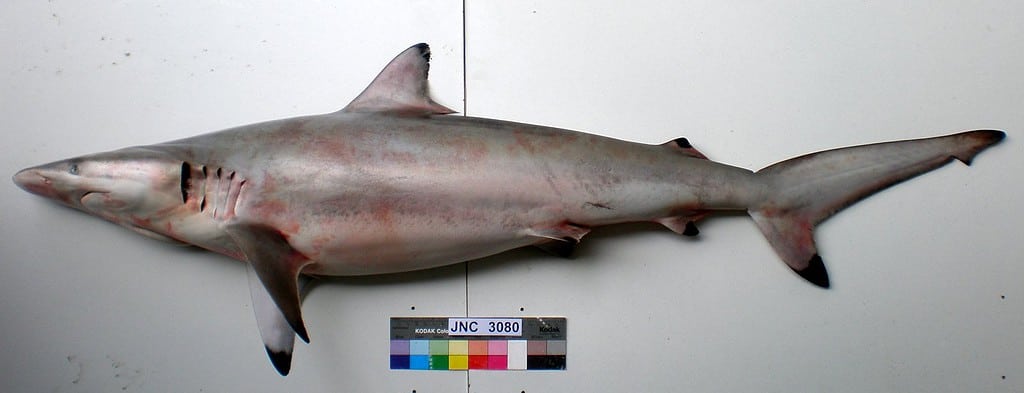
Spinner sharks hunt in coral reefs looking for large schools of fish.
©Jean-Lou Justine / CC BY-SA 3.0 – License
If you take a boat off the coast of Texas, chances are you will see spinner sharks jumping and hunting for food. They have a unique way of hunting where they power through a large school of fish with their mouth open, before emerging from the water and spinning about three times in the air. The spinning motions help spinner sharks consume the fish. While they are predators, they have small teeth better suited for small fish instead of humans, so you don’t have to worry!
3. Sandbar Shark
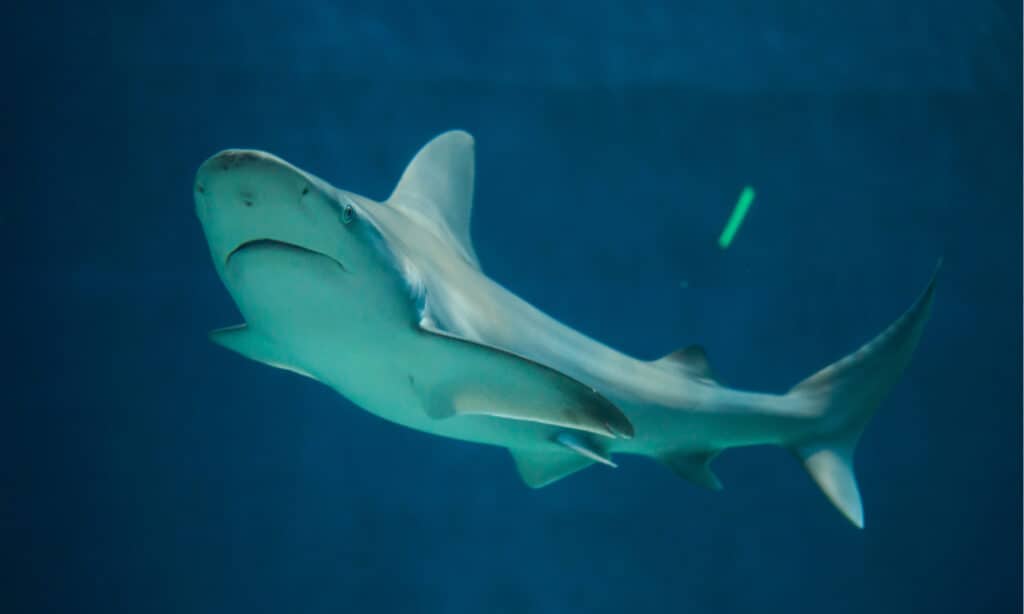
Sandbar sharks prey on small bony fishes and crustaceans.
©Vladimir Wrangel/Shutterstock.com
Usually, sandbar sharks live in the Caribbean, but you can still find them in Texas waters living in coral reefs, bays, and shallow sandbars. On average, these sharks weigh 100-200 pounds. These long and slender sharks are not the largest sharks in Texas waters, but they are long and compact! Texans visiting beaches may catch a glimpse of sandbar sharks’ large dorsal fins peeking out of the water. They travel to the coast when hunting large schools of fish, but rarely bother humans.
4. Finetooth Shark
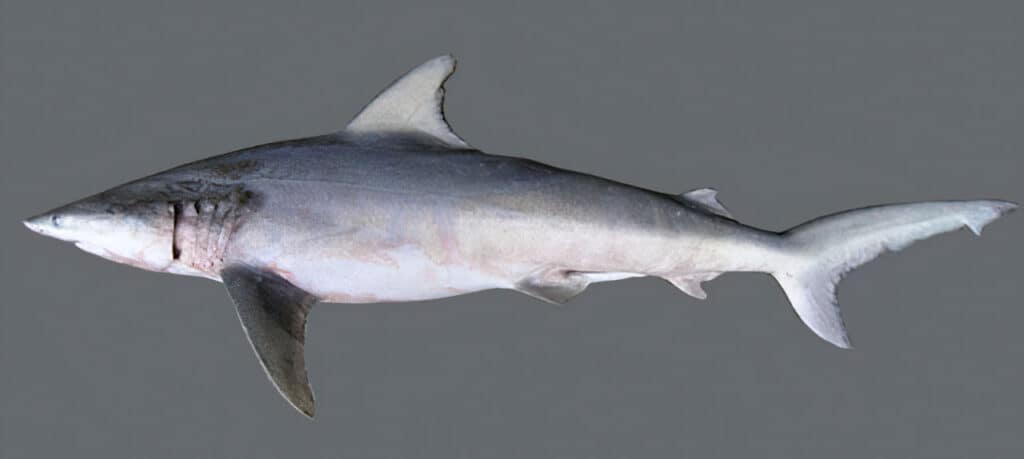
Finetooth sharks prefer swimming in shallow and coastal waters.
©Brenda Bowling, tpwd.texas.gov / public domain – License
While not as common as bonnethead sharks, finetooth sharks live in coastal Texas waters. They rarely dive deeper than 65 feet. Unlike other shark species, finetooth sharks swim in schools and hunt for bony fish. These slender and gray sharks are also mainly found in the Gulf of Mexico but are migratory. As soon as the water drops below 200C, they migrate south from the Atlantic Ocean. Fishers can legally fish for finetooth sharks in Texas, but the number they can catch is limited.
5. Caribbean Sharpnose Shark
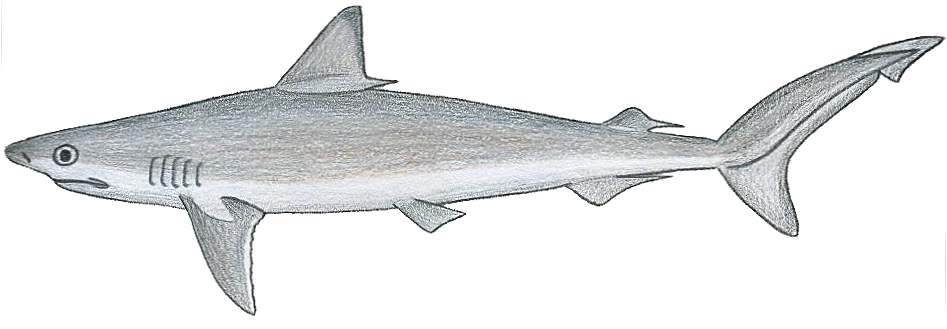
The recorded maximum length record for the Caribbean sharpnose shark is 3.6 feet.
©Tambja / CC BY-SA 3.0 – License
Caribbean sharpnose sharks live in the Caribbean and the western Atlantic Ocean. They are small sharks, as most males only grow up to 1.9 feet long. These small sharks also live in deep waters. Interestingly, unlike other shark species, they only live 8-10 years. This is just an estimate, though, as scientists have not had enough opportunities to study the lives of this shark species.
6. Blacktip shark
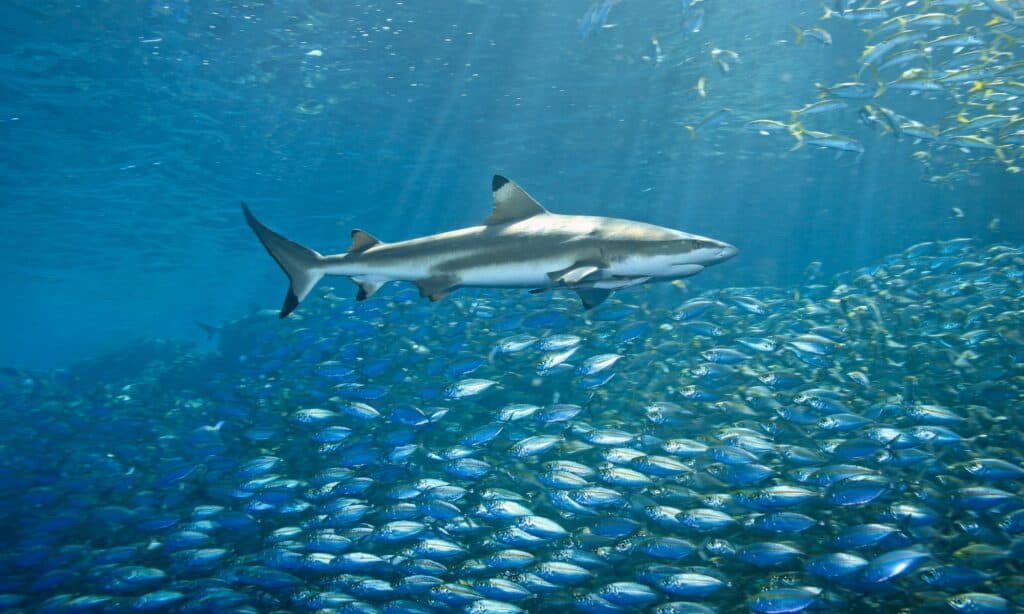
Blacktip sharks live in coral reefs and hunt with other reef sharks.
©iStock.com/cbpix
Blacktip sharks are not picky. During the day, they spend their time in deep waters in coral reefs with other reef shark species. They all hunt together and help take down large animals like other sharks, squids, and sometimes young dolphins. These sharks are very common in Texas since they frequent inshore waters. They are also a favorite for fishers since their meat tastes delicious. In the state of Texas, though, you can only fish and keep a blacktip shark if it is 24 inches and longer, and the limit is one shark per day.
7. Bonnethead Shark

Bonnethead sharks are often mistaken for mini hammerheads.
©FtLaud/Shutterstock.com
Although the picture above may look like a small hammerhead, it is actually a bonnethead shark. Bonnethead sharks are extremely common in Texas waters since they are small and swim near the coast. They have a round and shovel-like head shape and usually stop growing when 5 feet long. Since their mouths are at the bottom of their bodies, they are limited on what they can eat. Instead, bonnethead sharks hunt for crustaceans like shrimp, crabs, and sometimes barnacles. They also eat plants and meat, unlike other shark species.
8. Scalloped Hammerhead
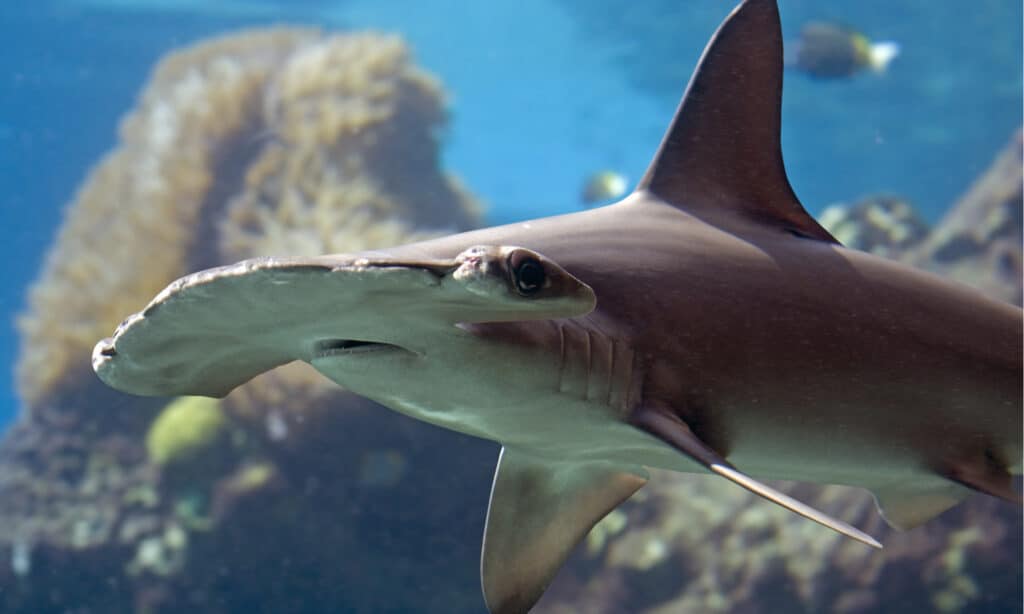
Scalloped hammerheads live solitary lives and hunt alone.
©Ian Scott/Shutterstock.com
Hammerheads are one of the few true lonely shark species in the world. They choose to hunt and travel alone without help from other sharks. These independent and hammer-shaped sharks live in coastal waters. Scalloped hammerheads also live in deep and warm waters. Sadly, the population is declining so fast that the sharks can’t keep up with their limited reproduction. Scalloped hammerheads are hunted by humans for their fins. The largest scalloped hammerhead shark recorded was 19 feet long.
9. Tiger Shark
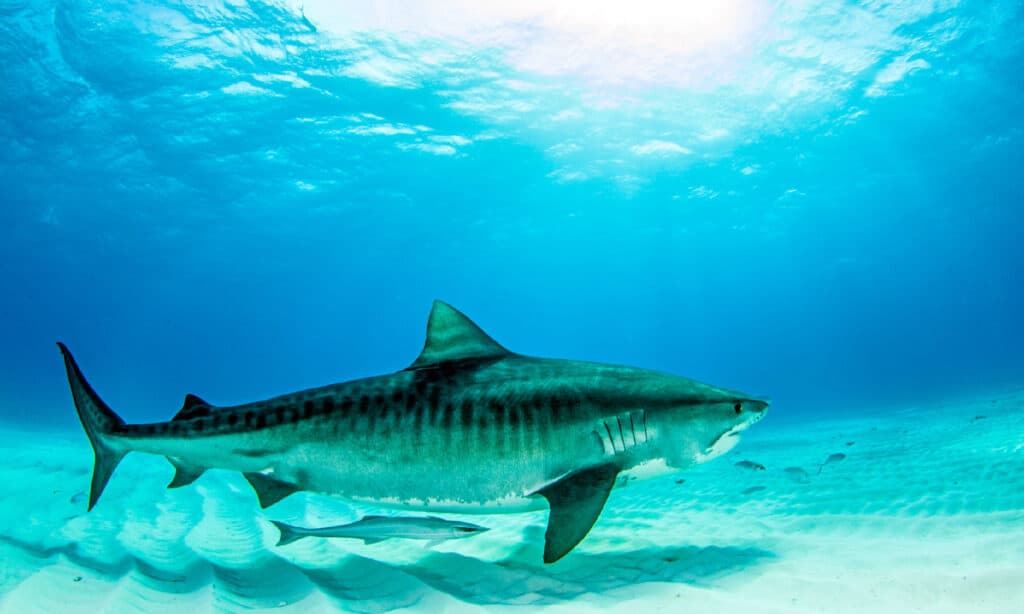
Tiger
sharks are the largest sharks in Texas coastal waters.
©iStock.com/Divepic
Fun fact, the biggest shark ever caught in Texas was a 1,129-pound and 13.5-foot-long tiger shark. Tiger sharks are common in Texas waters and are easy to spot because of their tiger-like stripes and spots on their backs and sides. They consume crabs, turtles, birds, small sharks, and stingrays. They are not picky eaters or swimmers but are unlikely to be found in the Mediterranean Sea. Tiger sharks stay away from humans but have accidentally bitten them before when unprovoked.
10. Whale Shark
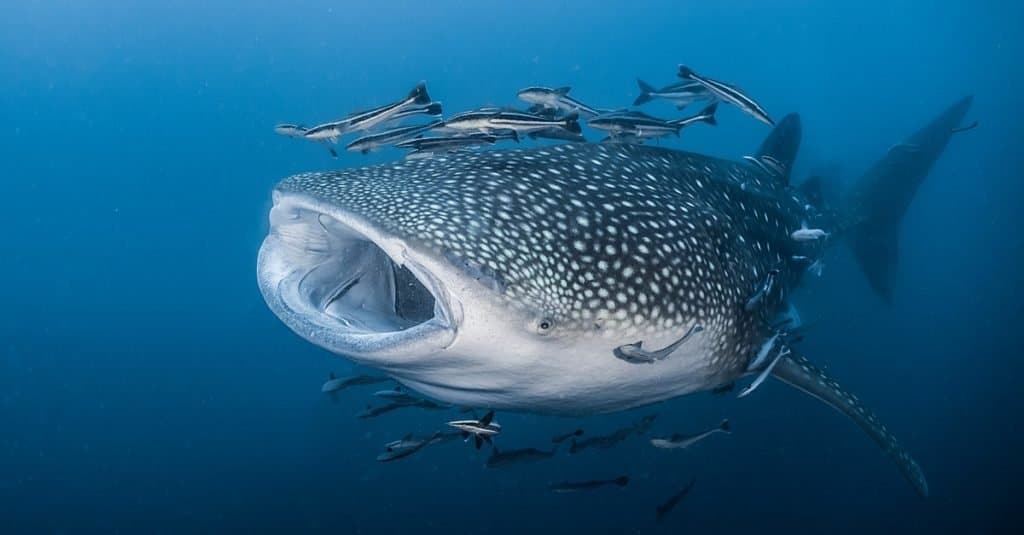
Whale sharks are endangered.
©Onusa Putapitak/Shutterstock.com
Whale sharks are a docile, but large shark species. They look and hunt more like whales than sharks, as they open their mouths to suck in fish. These large fish live in the Gulf of Mexico, and while they prefer swimming in deeper waters, you can still spot them as close as 100 miles off of the coast of Texas. They also don’t stay in one spot for long and travel large distances every day. However, they are slow swimmers and usually swim at speeds up to 3 miles per hour. Don’t let their adorable appearance fool you, they have over 3,000 small teeth, which help them consume crustaceans like shrimp. However, they pose no threats to humans.
Up Next:
- 10 Sharks in the Mediterranean Sea
- 10 Sharks in New Jersey Waters
- 10 Sharks Found in the Caribbean Sea
The photo featured at the top of this post is © le bouil baptiste/Shutterstock.com
Thank you for reading! Have some feedback for us? Contact the AZ Animals editorial team.






